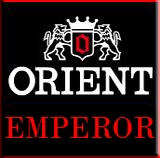|
|
|
MAZDA EFINI RX7 TUNED VERSION(FD)
1/18 AUTOART
Year/Anno : 1991
Color : Red with gold rims / Rossa con cerchi dorati
My rating/Mio Voto : 92/100
Value for Money/Rapporto qualità prezzo : 85/100
Original price/Prezzo medio : 160 €uro
Materiale: Die-cast metallo
Codice: 75969
Clicca il banner in alto per tornare alla Homepage e visionare altri modelli.
Click on the banner on the top of this page to return at the Homepage and see all the other models of my collection.
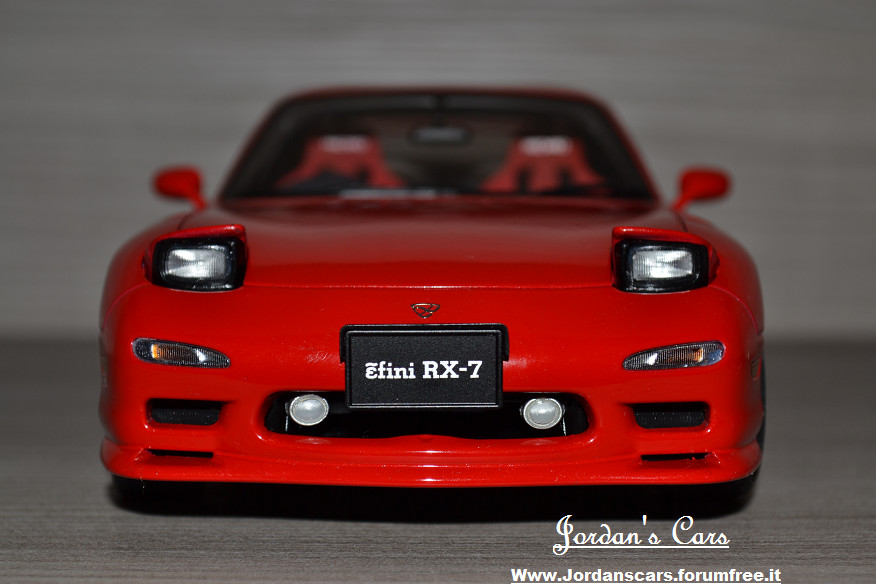
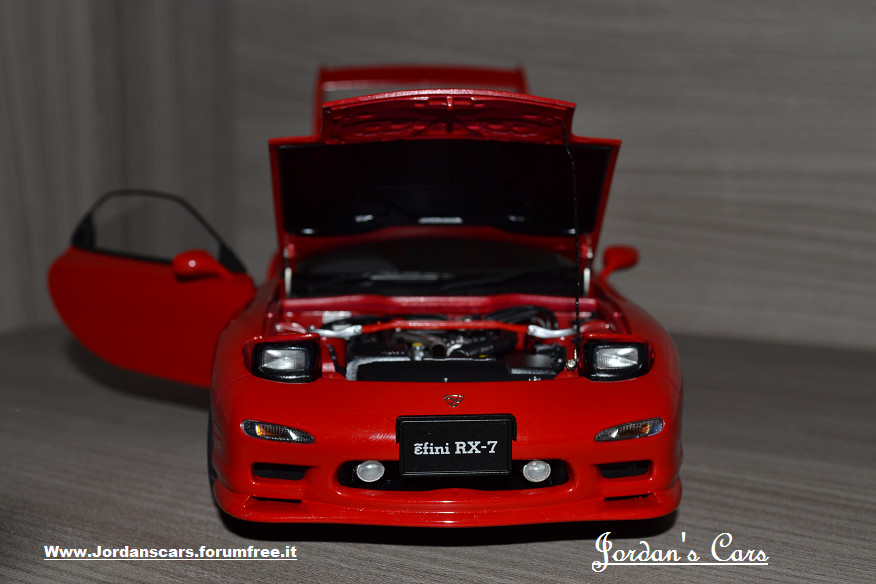
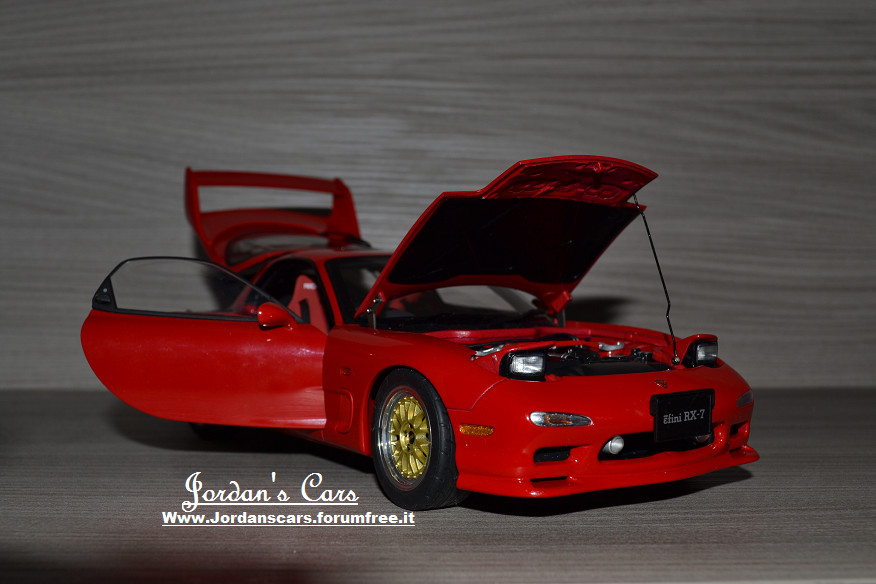
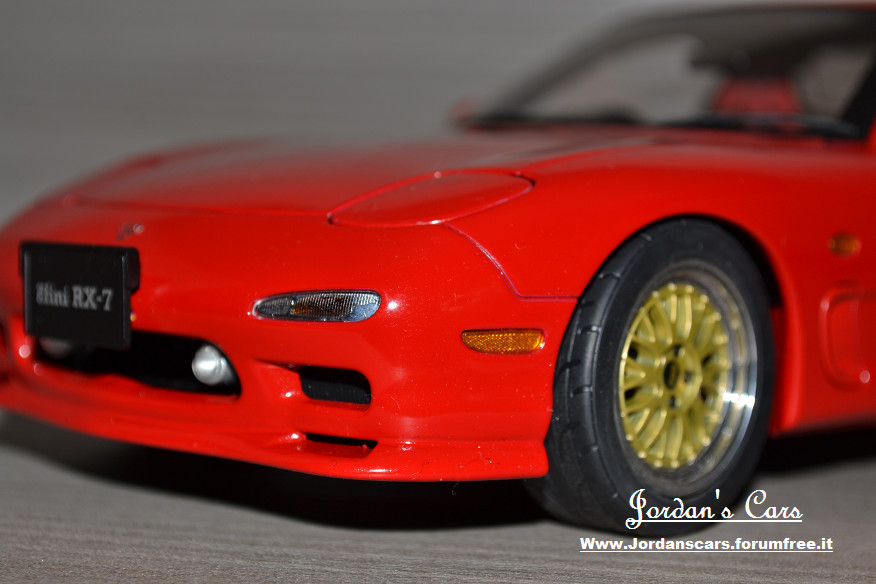
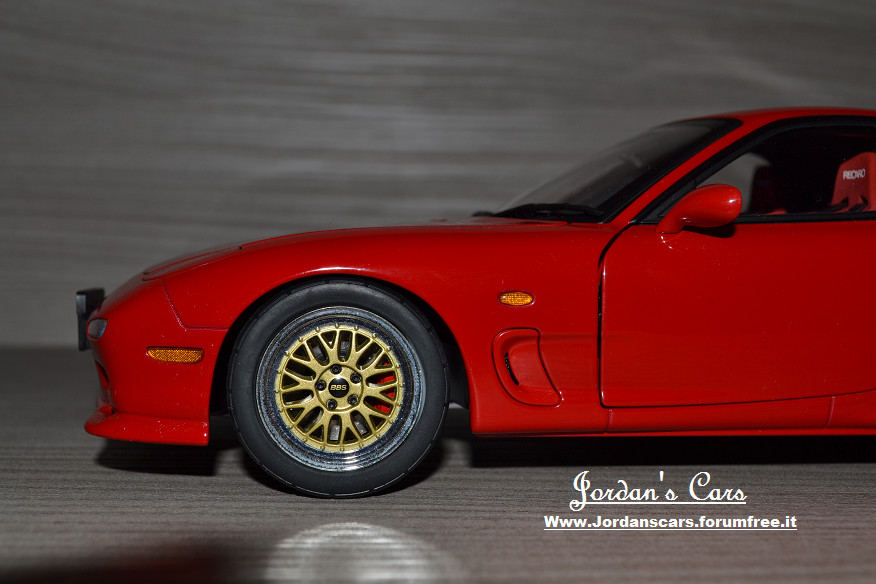
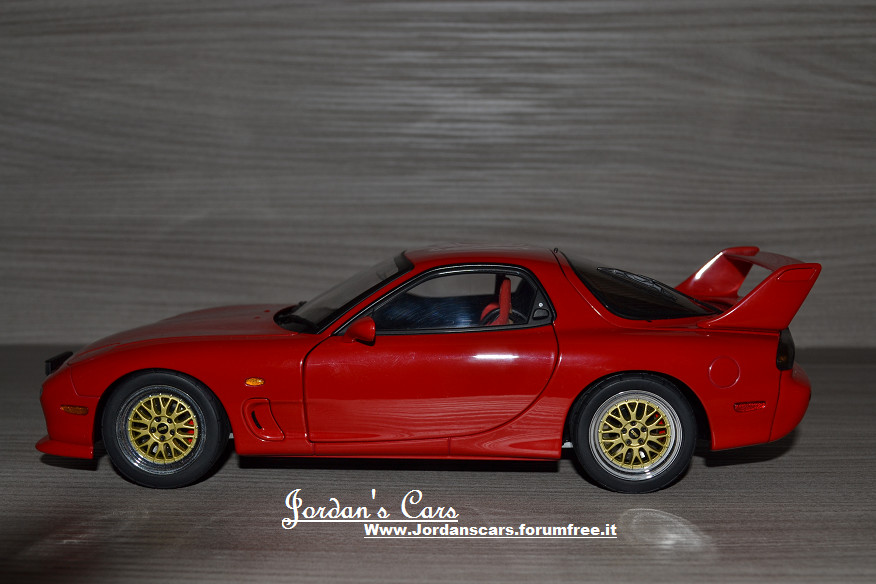
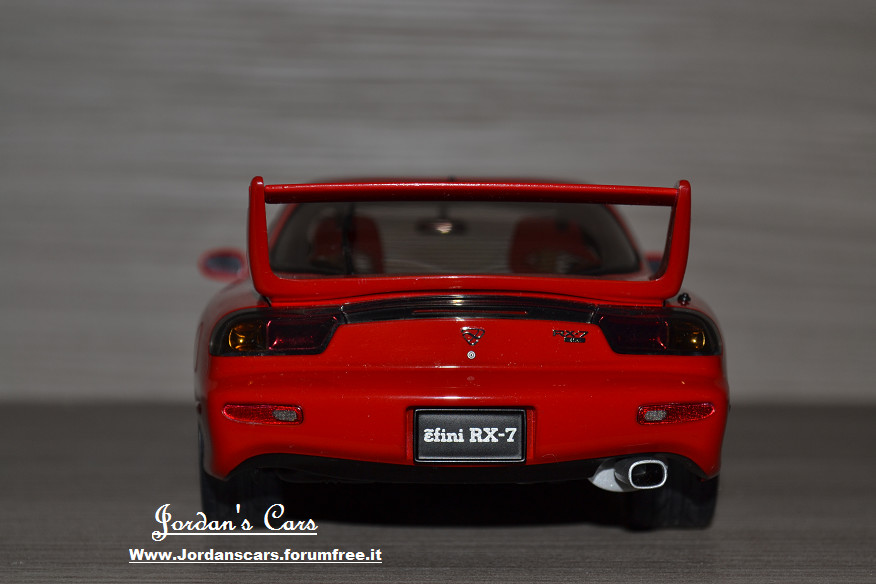
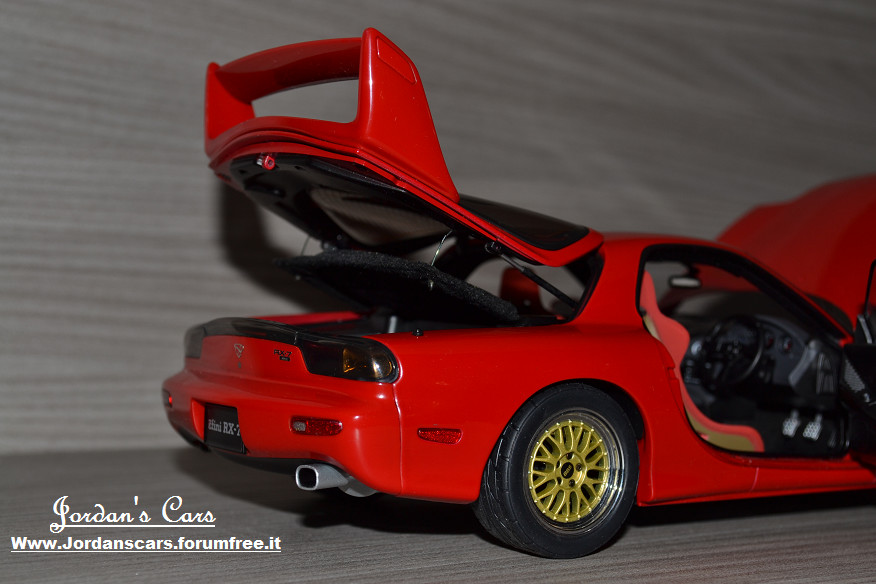
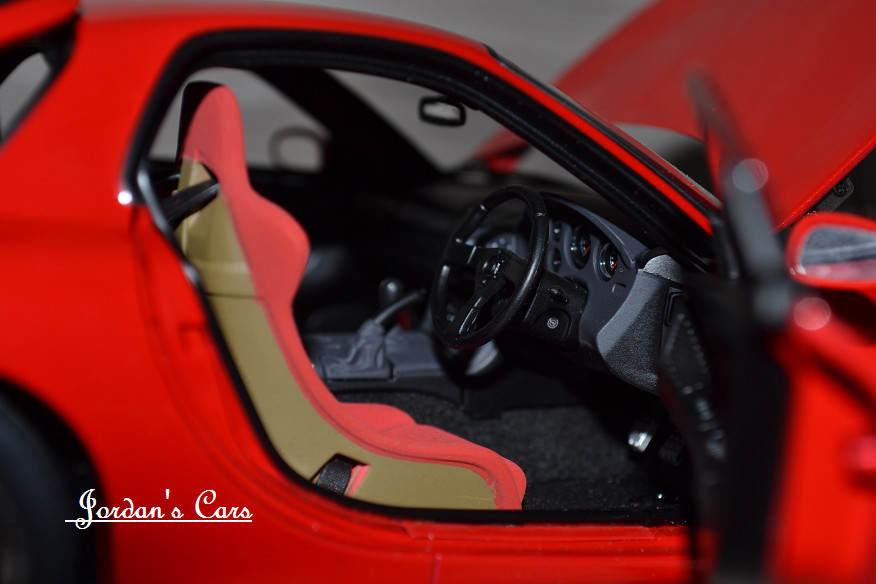
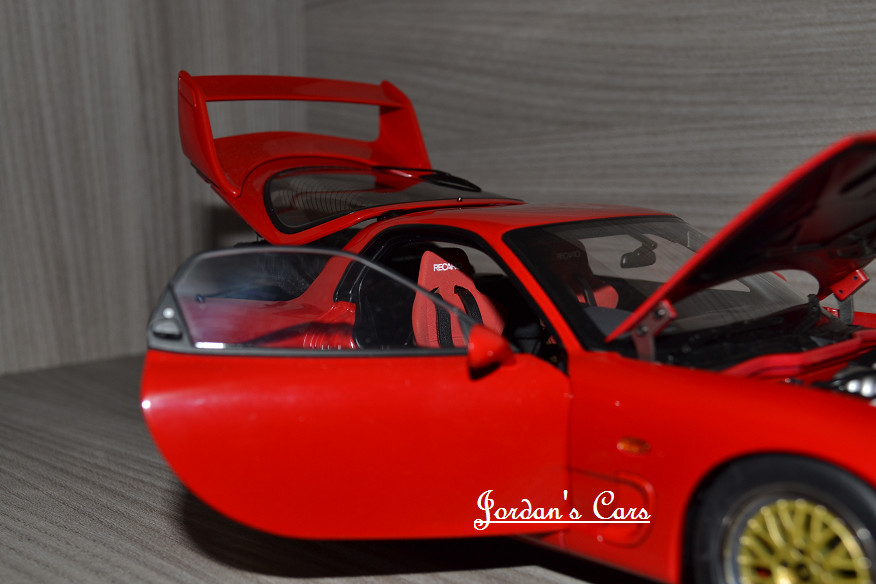
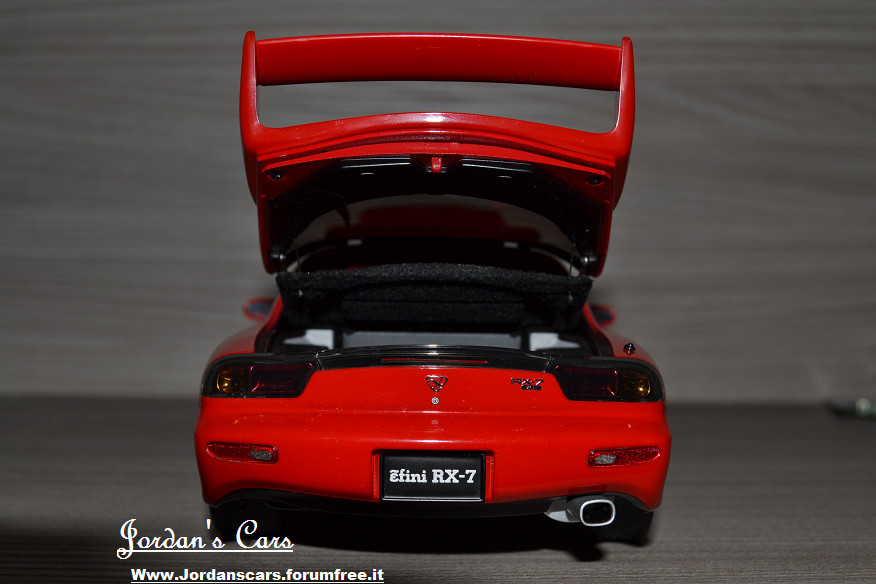
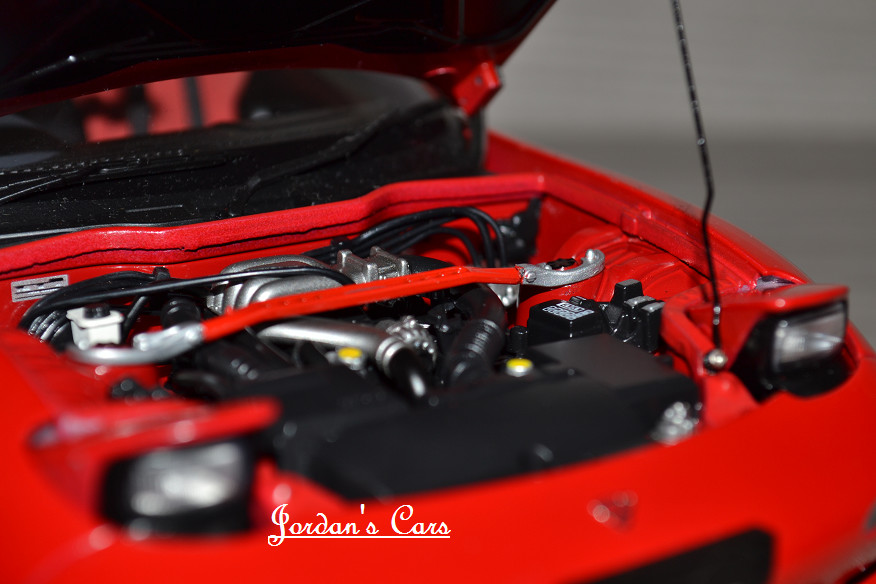
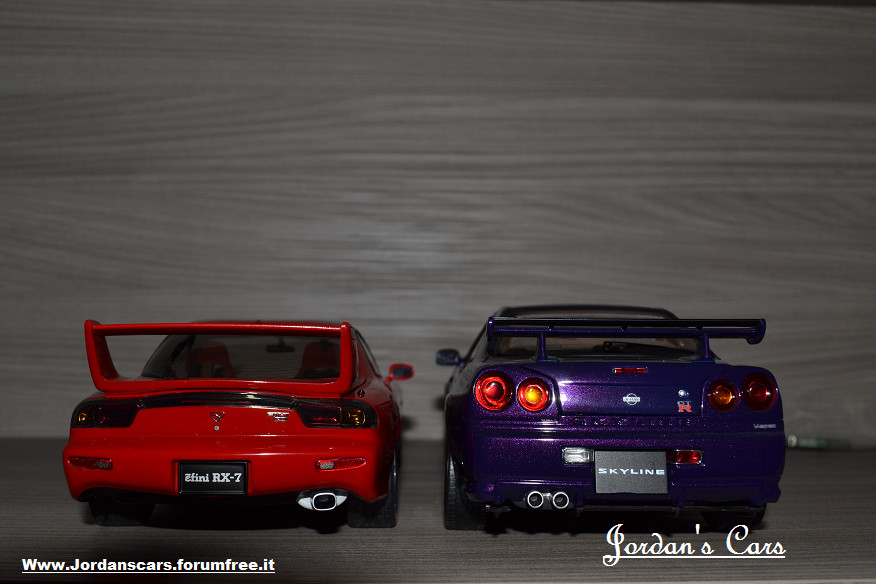
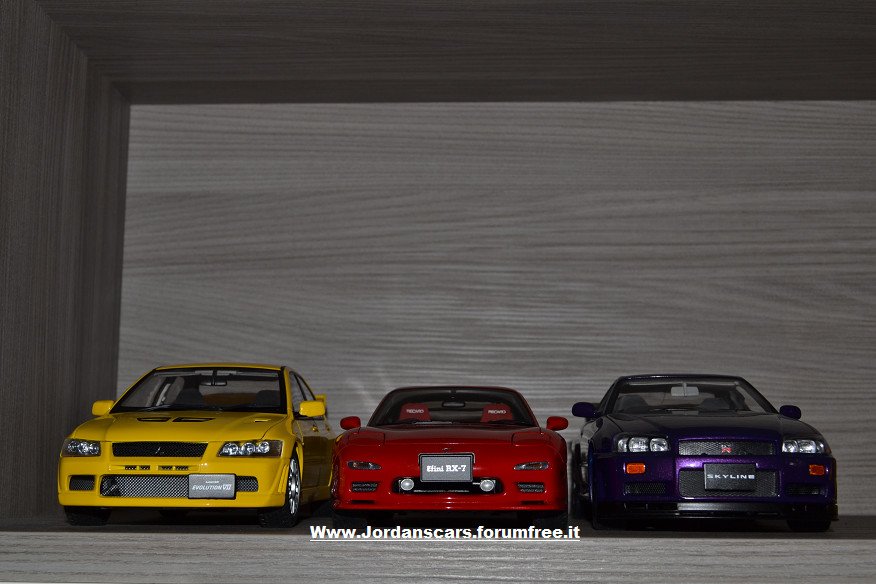
STORIA DELL'AUTO(wiki):
La Mazda RX-7 è un'automobile sportiva costruita dalla Mazda in tre generazioni tra il 1978 e il 2002. Caratteristica peculiare di questa vettura è il suo motore rotativo Wankel.
Commercializzata inizialmente solo in Oriente, è stata successivamente esportata in Europa e negli Stati Uniti.
Di questa coupé esistono tre generazioni, la prima presentata nel 1978, solo un anno dopo la cessazione della produzione della prima vettura di serie equipaggiata da tale motore, la NSU Ro 80, e l'ultima prodotta fino al 2002 (anche se le ultime versioni furono destinate solo al mercato interno giapponese e la produzione limitata a pochi esemplari). Venne sostituita nella produzione dalla Mazda RX-8.
La prima serie dell'auto venne equipaggiata da un birotore in grado di erogare 77 kW (105 CV) a 6.000 giri al minuto, e fornito di una coppia motrice di 147 N m a 4.000 rpm. La configurazione era quella classica delle vetture sportive del tempo con una linea abbastanza spigolosa, dei fari anteriori a scomparsa e una meccanica caratterizzata dalla trazione posteriore. Sbarcò in Europa con l'intenzione di concorrere con le migliori sportive del tempo come ad esempio la Porsche 924 a cui in parte somigliava.
Nel 1981 subì un leggero restyling che esteticamente interessava i paraurti, le modanatura laterali, i cerchi ed infine la fanaleria posteriore, che perdeva la zona di depressione centrale tipica del modello, per un più armonioso comparto con targa incorporata (in Europa).
Motoristicamente, grazie ad alcuni affinamenti, si raggiungevano gli 85 kW (115 CV), ed il comparto dinamico della vettura veniva ampiamente migliorato grazie ai quattro freni a disco di serie e ad una piccola modifica della sospensione anteriore.
L'interno poi passava dal tipico stile anni 70 del modello precedente (si veda la cromatura che correva lungo tutto l'abitacolo) ad un più moderno uso dei materiali e degli accessori (con cristalli e retrovisori elettrici su tutti i modelli europei). Della prima serie vennero prodotti 474.565 esemplari, di cui 377.878 venduti sul mercato statunitense dove ancora oggi ha una forte schiera di appassionati.
Le motorizzazioni iniziali della seconda serie, la cui presentazione avvenne nel 1986, erano un aspirato da 146 CV (108 kW) o una versione sovralimentato da 182 CV (141 kW). Nel 1988 la coupé venne affiancata anche da una versione cabriolet che rimase però in produzione per soli 3 anni, nonostante il buon accoglimento da parte del mercato, specialmente di quello nordamericano.
A metà del 1989 venne presentata la versione rivista: l'aspirato raggiungeva i 160 CV (ma non era più disponibile in Europa) e la sovralimentata arrivava a 200 CV. Questo modello fu l'unico ufficialmente importato in Italia, nella versione denominata Turbo II, che comprendeva una ricca dotazione di serie (interni in pelle, tetto apribile elettrico, climatizzatore, cruise control).
Esteticamente era riconoscibile dal modello del 1986 per i fanali posteriori, con le luci dei freni rotonde, e per differenti paraurti ora in tinta con la carrozzeria.
La terza e ultima serie (modello FD3S) vide la luce nell'ottobre del 1991 con un ulteriore raffinamento della linea per adeguarla ai mutati canoni estetici dell'epoca, che ne fece una delle sportive giapponesi più apprezzate per lo stile. Venne esportata al di fuori dei confini giapponesi fino al 1996 e mantenuta in produzione (solo per il mercato interno) con il marchio Efini, pur conservando il nome RX-7, per gli ultimi anni.
Il motore montato su questa versione era il 13B REW (birotore a ciclo Wankel da 1308 cm³ totali) che, con rapporto di compressione pari a 9:1 e sovralimentazione mediante due turbocompressori sequenziali ed intercooler aria-aria, erogava nella versione europea 239 CV a 6500 giri/min (255 CV in quella giapponese), mentre nelle versioni Type R e Type RS, in vendita per il mercato interno dal '99 al 2002, sviluppava 280 CV, dati però solo dichiarati dalla casa per un vincolo tra le case costruttrici giapponesi che imponeva di non superare quella potenza, in realtà quel motore superava alla prova dei fatti i 300 CV.
Il sistema di turbine sequenziali era sofisticato per una vettura di normale produzione. Sviluppato in collaborazione con Hitachi, era composto da un gruppo turbocompressori in blocco unico, specificatamente progettato, consistente di due turbine di ugual dimensioni Hitachi HT12, gemellate nel lato caldo, azionato dai gas di scarico provenienti dai rotori.
Il sistema, nato per sopperire ai limiti tecnici dei turbocompressori di allora, era stato studiato per fornire una curva di coppia generosa e molto piatta fin dai bassi regimi. Un solo turbocompressore piccolo infatti avrebbe consentito una coppia poderosa ai bassi regimi, ma fornito un motore molto soffocato agli alti; per contro un turbocompressore molto grosso avrebbe aumentato eccessivamente il ritardo della risposta all'acceleratore (turbo-lag) pur fornendo una buona potenza agli alti. Il sistema impiegato sulla RX-7 è di fatto concettualmente semplice, ma di esecuzione assai complicata: i due turbocompressori erano azionati dai gas di scarico e soffianti nel collettore di aspirazione prima singolarmente e poi in coppia, in parallelo. La prima turbina consentiva una sovralimentazione pari a 10 psi (0,689 bar) a partire da 1800 giri/min, la seconda turbina (nel frattempo tenuta in una sorta di "stand-by") era resa operativa a partire dai 4000 giri/min e permetteva di mantenere i 10 psi (0,689 bar) di sovralimentazione fino alla linea rossa dei 7500 giri/min (7000 giri/min per la versione europea). Il passaggio dalla modalità "singola" alla modalità "doppia" tra i 3500 ed i 4000 giri/min vedeva la pressione di sovralimentazione scendere intorno ad 8 psi (0,551 bar), per questo motivo sulla RX-7 si parla non di pressione di sovralimentazione ma di schema della pressione di sovralimentazione, appunto definito 10-8-10.
Tutto il sistema era gestito tramite attuatori pneumatici, valvole a solenoide, valvole by-pass e valvole di sfogo e gestito tutto dalla centralina elettronica del motore, per la sua complessità era spesso fonte di problemi, dovuti in gran parte alla manutenzione che non veniva eseguita correttamente.
Il sistema di iniezione MAP (Manifold Absolute Pressure) L-Jetronic studiato da Bosch prevedeva due iniettori per ogni rotore, azionati anch'essi in modo sequenziale: il primo iniettore da 550 cm³/min alimentava il rotore nel campo di funzionamento del primo turbocompressore, il secondo iniettore da 850 cm³/min veniva azionato in concomitanza con l'entrata in funzionamento del secondo turbocompressore. Per lo stesso motivo, la pompa benzina era azionata a due velocità.
Il motore in questione adottava anche la doppia candela di accensione per ogni rotore, gestito da un sistema elettronico con sensore di detonazione piezo-elettrico, per attenuare il problema del Wankel di avere camere di combustione schiacciate e allungate che davano problemi per il fronte di fiamma che doveva viaggiare da un punto all'altro della camera in pochissimo tempo.
Per quanto riguarda le sospensioni la vettura era dotata del sistema a doppi bracci triangolari sovrapposti di lunghezza ineguale all'anteriore, mentre al posteriore presentava un sistema Multilink. Sia all'anteriore che al posteriore troviamo ammortizzatori telescopici e molle elicoidali, completati da barre antirollio. I duomi delle sospensioni erano rinforzati da una specifica barra al posteriore ed una regolabile all'anteriore, non presente però nella versione touring e base.
I freni erano a dischi ventilati da 294 mm con pinze flottanti a 4 pistoncini all'anteriore e a dischi ventilati da 294 mm con pinza fissa a singolo pistoncino al posteriore. ABS a 3 canali di serie su tutte le versioni. Servosterzo con assistenza variabile in base alla velocità.
La trazione alle ruote posteriori con differenziale a slittamento limitato di tipo Torsen avveniva tramite un cambio manuale, denominato Type R152a a 5 marce sincronizzate. I rapporti delle marce erano: prima 3.483:1; seconda 2.015:1; terza 1.391:1; quarta 1.000:1; quinta 0.719:1; retromarcia 3.288:1; rapporto finale 4.100:1. Era disponibile anche una trasmissione di tipo automatico denominata R4A-EL controllata elettronicamente a 4 rapporti e con convertitore di coppia.
Le prestazione dichiarate erano di una accelerazione da 0 a 100 km/h in 5,5 secondi e 250 km/h di velocità massima, tutto questo grazie anche al peso contenuto di circa 1280 kg.
Il basso centro di gravità, la configurazione con motore anteriore dietro l'asse delle ruote e la trazione al posteriore, unitamente ad una eguale distribuzione dei pesi di 50:50 sui due assi hanno reso l'RX-7 una vettura dalla buona guidabilità e performante se portata al limite.
Nel 2002, ultimo anno di produzione della RX-7, venne presentata una versione ad alte prestazioni, denominata Spirit R. Essa era disponibile nelle configurazioni Type A, B e C. La prima di queste varianti era una biposto dotata di cambio manuale a cinque rapporti, sedili sportivi Recaro che diminuiscono il peso complessivo della vettura di 10 kg e impianto frenante a disco potenziato.
La Mazda RX-7 è stata iscritta nel 2002 al campionato Super GT nipponico nella classe GT300 dal team RE Amemiya. Oltre ai nuovi sistema di sicurezza prescritti dal campionato e a nuove appendici aerodinamiche, la vettura è stata dotata di un propulsore potenziato a 400 CV di potenza.
__________________________________________________________________________________
ɛ̃fini (アンフィニ) was a luxury vehicle division of Japanese automaker Mazda that operated between 1991 and 1997 in Japan only. Its inception as a brand emerged in the late 1980s when Mazda diversified its sales channels in the Japanese market with the launch of three new marques. The company created Autozam, Eunos, and ɛ̃fini, in addition to the Mazda and Ford brands already marketed there. This selective marketing experiment ended in the mid-1990s due to economic conditions, largely attributed to the collapse of the Japanese asset price bubble in 1991. As a brand, ɛ̃fini encompassed most, if not all dealers formerly under Mazda's "Auto" dealer chain. It's pronounced like the French word infini. The name is actually written with a tilde over the initial lower case e (as in ɛ̃), and can therefore be assumed to be IPA, the pronunciation symbols universally taught in Japan, and quite often used in product naming.
The ɛ̃fini marque was a luxury-oriented brand, as opposed to the more mainstream, fun to drive Eunos brand, traditional Mazda, and entry level Autozam. The vehicles sold didn't comply with Japanese government exterior and engine displacement regulations which classed all vehicles sold as ɛ̃fini as exclusive luxury products. The length of the MS-6 was the same as the MS-8 at 4,695 mm (184.8 in). Both shared the V6 2.0 L, while the MS-6 offered the convenience of a hatchback bodystyle, and the MS-8 offered space efficiency of bench seats for both front and rear passengers and the open-air feeling of a hardtop sedan bodystyle.
The ɛ̃fini name and logo are not to be confused with several limited-edition second generation (FC) RX-7s, the "Infini" edition (marked with an infinity sign "∞"), from the late 1980s.
From 1991 until 1997, when the ɛ̃fini dealership was integrated into Mazda locations, Citroën products were sold to Japanese buyers, as well as Mazda's Eunos locations. Currently, there are a few Japanese Mazda dealerships that still maintain the sales channels, but sell Mazda-branded products.
The Mazda RX-7 is a sports car that was produced by the Japanese automaker Mazda from 1978 to 2002. The first RX-7 featured an 1,146 cc (69.9 cu in) twin-rotor Wankel rotary engine and a front-midship, rear-wheel drive layout. The RX-7 replaced the RX-3, with both models sold in Japan as the Mazda Savanna.
The original RX-7 was a sports car with pop-up headlamps. The compact and lightweight Wankel rotary engine is situated slightly behind the front axle, a configuration marketed by Mazda as "front mid-engine". It was offered as a two-seat coupé, with optional "occasional" rear seats in Japan, Australia, the United States, and other parts of the world. The rear seats were initially marketed as a dealer-installed option for the North American markets.
The RX-7 made Car and Driver magazine's Ten Best list five times. 811,634 RX-7s were produced.
The RX-7 has become notable through pop culture such as Battle Fever J, Ultraman 80, Space Sheriff Shaider, Kyojuu Tokusou Juspion, Choudenshi Bioman, Shakotan Boogie, Kamen Rider Black RX, Wangan Midnight, Super Rescue Solbrain, Initial D, Need for Speed, The Fast and the Furious series, Forza Motorsport and Gran Turismo.
The third generation of the RX-7, FD (with FD3S for Japan and JM1FD for the USA VIN), featured an updated body design. The 13B-REW was the first-ever mass-produced sequential twin-turbocharger system to export from Japan, boosting power to 255 PS (188 kW; 252 hp) in 1993 and finally 280 PS (206 kW; 276 hp) by the time production ended in Japan in 2002.
In Japan, sales were affected by the fact that this series RX-7 no longer complied with Japanese Government dimension regulations, and Japanese buyers were liable for yearly taxes for driving a wider car compared to previous generations. As the RX-7 was now considered an upper-level luxury sportscar due to the increased width dimensions, Mazda offered two smaller sports cars, the Eunos Roadster, and the Eunos Presso hatchback.
The sequential twin turbocharged system, introduced on this series in 1992, was a very complex piece of engineering, developed with the aid of Hitachi and previously used on the exclusive to Japan Cosmo series (JC Cosmo=90–95). The system was composed of two turbochargers, one to provide boost at low RPM. The second unit was on standby until the upper half of the rpm range during full throttle acceleration. The first turbocharger provided 10 psi (0.7 bar) of boost from 1800 rpm, and the second turbocharger was activated at 4000 rpm to maintain 10 psi (0.7 bar) until redline. The changeover process occurred at 4500 rpm, with a momentary dip in pressure to 8 psi (0.6 bar), and provided semi-linear acceleration and a wide torque curve the throughout the entire rev range under "normal operation". However, under performance driving the changeover process produced a significant increase in power and forced technical drivers to adjust their driving style to anticipate and mitigate any over-steer during cornering. Many owners modified their turbo control systems into a parallel system by removing the exhaust manifold Turbo Control Valve and the turbo coupling "y-pipe" Charge Control Actuator and valve in order to remove the changeover process and to simplify the control system for reliability. Turbo lag was greatly increased below 4500 rpm, but smooth and linear boost could be obtained. The stock turbo control system used 4 control solenoids, 4 actuators, both a vacuum and pressure chamber, and several feet of preformed vacuum/pressure hoses all of which were prone to failure in part to complexity and the inherent high temperatures of the rotary engine.
Australia had a special high-performance version of the RX-7 in 1995, named the RX-7 SP. This model was developed to achieve homologation for racing in the Australian GT Production Car Series and the Eastern Creek 12 Hour production car race. An initial run of 25 originals were made, and later an extra 10 were built by Mazda due to demand. The RX-7 SP produced 204 kW (274 hp) and 357 N·m (263 lb·ft) of torque, compared to the 176 kW (236 hp) and 294 N·m (217 lb·ft) of the standard version. Other changes included a race-developed carbon fibre nose cone and rear spoiler, a carbon fibre 120 L fuel tank (as opposed to the 76 L tank in the standard car), a 4.3:1-ratio rear differential, 17-inch wheels, larger brake rotors and calipers. An improved intercooler, exhaust, and modified ECU were also included. Weight was reduced significantly with the aid of further carbon fibre usage including lightweight vented bonnet and Recaro seats to reduce weight to 1218 kg (from 1250 kg). It was a serious road-going race car that matched their rival Porsche 911 RS CS for the final year Mazda officially entered. The formula paid off when the RX-7 SP won the 1995 Eastern Creek 12 Hour, giving Mazda the winning 12hr trophy for a fourth straight year. The winning car also gained a podium finish at the international tarmac rally Targa Tasmania months later. A later special version, the Bathurst R, was released in 2001 to commemorate this, in Japan only.
In the United Kingdom, for 1992, customers were offered only one version of the FD, which was based on a combination of the US touring and the base model. For the following year, in a bid to speed up sales, Mazda reduced the price of the RX-7 to £25,000, down from £32,000, and refunded the difference to those who bought the car before that was announced. The FD continued to be imported to the UK until 1996. In 1998, for a car that had suffered from slow sales when it was officially sold, with a surge of interest and the benefit of a newly introduced SVA scheme, the FD would become so popular that there were more parallel and grey imported models brought into the country than Mazda UK had ever imported.
Series 6 (1991–1995) was exported throughout the world and had the highest sales. In Japan, Mazda sold the RX-7 through its ɛ̃fini brand as the ɛ̃fini RX-7. Models in Japan included the Type R, the lightweight sports model Type RZ, the Type RB, the A-spec and the Touring X, which came with a four-speed automatic transmission. Only the 1993–1995 model years were sold in the U.S. and Canada. Series 6 came with 255 PS (188 kW; 252 hp) and 294 N·m (217 lb·ft).
In 1993, three North American models were offered; the "base", the touring, and the R models. The touring FD included a sunroof, fog lights, leather seats, a rear window wiper and a Bose Acoustic Wave system. The R (R1 in 1993 and R2 in 1994–95) models featured stiffer suspensions, an additional engine oil cooler, an aerodynamics package, purple-hued microfiber seats, and Z-rated tires. In 1994, the interior received a small update to include a passenger air bag, and a PEG (performance equipment group) model was offered. This model featured leather seats and a sunroof. It did not include the fog lights or Bose stereo of the touring package. In 1995, the touring package was replaced by the PEP (popular equipment package). The PEP package contained leather seats, sunroof and fog lights, but didn't have the Bose Stereo nor the rear window wiper.
In Europe, only 1152 examples of this model were sold through the official Mazda network. Only one spec was available and it included twin oil-coolers, electric sunroof, cruise control and the rear storage bins in place of the back seats. It also has the stiffer suspension and strut braces from the R models. Germany top the sales with 446 cars, while UK is second at 210 and Greece third with 168. The European models also received the 1994 interior facelift, with a passenger air bag.
Series 7 (1996–1998) included minor changes to the car. Updates included a simplified vacuum routing manifold and a 16-bit ECU which combined with an improved intake system netted an extra 10 PS (7 kW). This additional horsepower was only available on manual transmission cars as the increase in power was only seen above 7000rpm, which was the redline for automatic transmission equipped cars. The rear spoiler and tail lights were also redesigned. The Type RZ model was now equipped with larger brake rotors as well as 17 inch BBS wheels. In Japan, the Series 7 RX-7 was marketed under the Mazda and ɛ̃fini brand name. The Series 7 was also sold in Australia, New Zealand and the UK. Series 7 RX-7s were produced only in right-hand-drive configuration.
Series 8 (January 1999– August 2002) was the final series, and was only available in the Japanese market. More efficient turbochargers were available on certain models, while improved intercooling and radiator cooling was made possible by a redesigned front fascia with larger openings. The seats, steering wheel, and instrument cluster were all changed. The rear spoiler was modified and gained adjustability on certain models. Three horsepower levels are available: 255ps for automatic transmission equipped cars, 265ps for the Type RB, and 280ps available on the top-of-the-line sporting models. The high-end "Type RS" came equipped with Bilstein suspension and 17-inch wheels as standard equipment, and reduced weight to 1,280 kg (2,822 lb). Power was increased with the addition of a less restrictive muffler and more efficient turbochargers which featured abradable compressor seals, 280 PS (206 kW; 276 hp) with 313.8 N·m (231 lb·ft) of torque as per the maximum Japanese limit. The Type RS had a brake upgrade by increasing rotor diameter front and rear to 314 mm (12.4 in) and front rotor thickness from 22 mm (0.9 in) to 32 mm (1.3 in). The Type RS version also sported a 4.30 ratio differential, providing a significant reduction in its 0–100 km/hr time. The gearbox was also modified, 5th gear was made longer to reduce cruising rpm and improve fuel efficiency. The very limited edition Type RZ version included all the features of the Type RS, but at a lighter weight (at 1270 kg). It also featured custom gun-metal colored BBS wheels and a custom red racing themed interior. An improved ABS system worked by braking differently on each wheel, allowing the car better turning during braking. The effective result made for safer driving for the average buyer. Easily the most collectible of all the RX-7s were the last 1,500 run-out specials. Dubbed the "Spirit R", they combined all the "extra" features Mazda had used on previous limited-run specials with new exclusive features like cross-drilled brake rotors. Sticker prices when new were 3,998,000 yen for Type-A and B and 3,398,000 yen for Type-C. Mazda's press release said "The Type-A Spirit R model is the ultimate RX-7, boasting the most outstanding driving performance in its history."
There are three models of "Spirit R": the "Type A", "Type B", and "Type C". The "Type A" is a two-seater with a 5-speed manual transmission. It features lightweight red trim Recaro front seats as seen in the earlier RZ models. The "Type B" has a 2+2 seat configuration and also sports a five-speed manual transmission. The "Type C" is also a 2+2, but has a four-speed automatic transmission. Of the 1504 Spirit R's made, over 1000 were Type A's. An exclusive Spirit R paint color, Titanium Grey, adorned over 700 of the 1500 cars sold.
In Japan the FD3S production span is categorized into 6 models: #1 from 1991/12, #2 from 1993/08, #3 from 1995/03, #4 from 1996/01, #5 from 1998/12 and #6 from 2000/10. The model number (1 to 6) actually shows as the first digit of the 6 digits long JDM VIN, for example in VIN# FD3S-ABCDEF the A is the model number. A total of 9 limited editions (type RZ in 1992/10 (300 cars), RZ 1993/10 (150), R-II Bathurst 1994/09 (350), R Bathurst X 1995/07 (777), RB Bathurst X 1997/01 (700), RS-R 1997/10 (500), RZ 2000/10 (325), R Bathurst R 2001/08 (650), Spirit R 2002/04 (1500)) and 2 special editions (Bathurst R 1995/02, R Bathurst 2001/12) were produced.

MODELLI CORRELATI/RELATED MODELS:
MITSUBISHI LANCER EVO ---> https://jordanscars.forumfree.it/?t=72035105
|
|





















